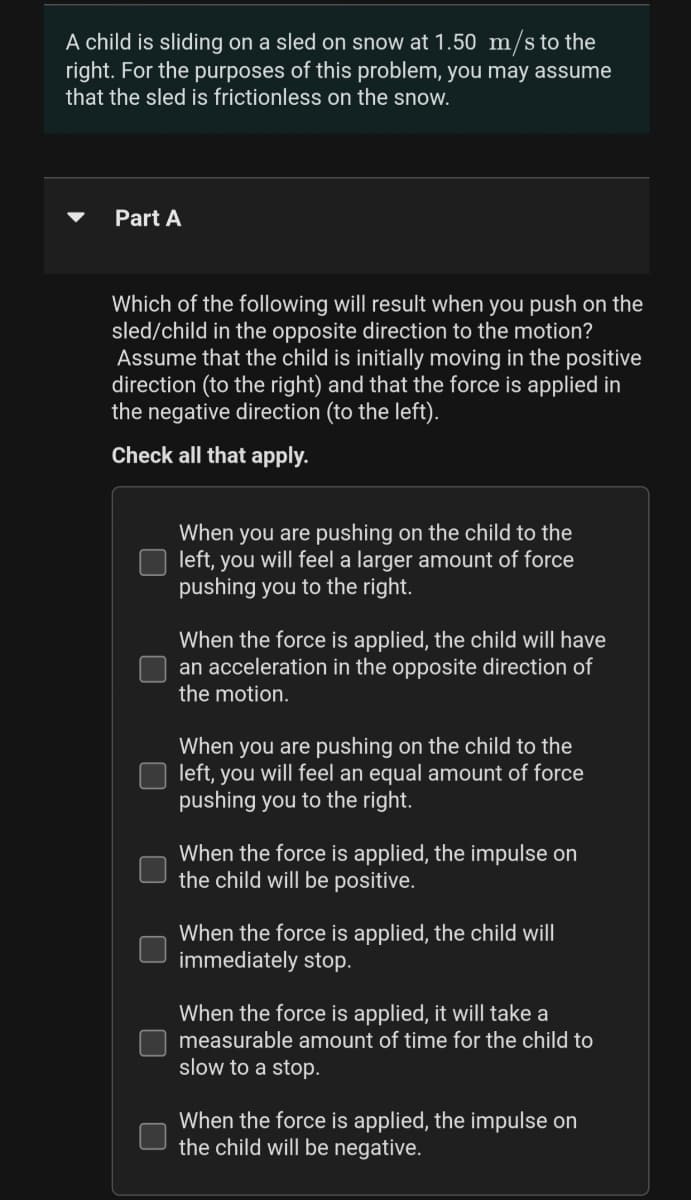A child is sliding on a sled on snow at 1.50 m/s to the right. For the purposes of this problem, you may assume that the sled is frictionless on the snow. Part A Which of the following will result when you push on the sled/child in the opposite direction to the motion? Assume that the child is initially moving in the positive direction (to the right) and that the force is applied in the negative direction (to the left). Check all that apply. When you are pushing on the child to the left, you will feel a larger amount of force pushing you to the right. When the force is applied, the child will have an acceleration in the opposite direction of the motion. When you are pushing on the child to the left, you will feel an equal amount of force pushing you to the right. When the force is applied, the impulse on the child will be positive. When the force is applied, the child will immediately stop. When the force is applied, it will take a measurable amount of time for the child to slow to a stop. When the force is applied, the impulse on the child will be negative.
A child is sliding on a sled on snow at 1.50 m/s to the right. For the purposes of this problem, you may assume that the sled is frictionless on the snow. Part A Which of the following will result when you push on the sled/child in the opposite direction to the motion? Assume that the child is initially moving in the positive direction (to the right) and that the force is applied in the negative direction (to the left). Check all that apply. When you are pushing on the child to the left, you will feel a larger amount of force pushing you to the right. When the force is applied, the child will have an acceleration in the opposite direction of the motion. When you are pushing on the child to the left, you will feel an equal amount of force pushing you to the right. When the force is applied, the impulse on the child will be positive. When the force is applied, the child will immediately stop. When the force is applied, it will take a measurable amount of time for the child to slow to a stop. When the force is applied, the impulse on the child will be negative.
University Physics Volume 1
18th Edition
ISBN:9781938168277
Author:William Moebs, Samuel J. Ling, Jeff Sanny
Publisher:William Moebs, Samuel J. Ling, Jeff Sanny
Chapter6: Applications Of Newton's Laws
Section: Chapter Questions
Problem 40P: A service elevator takes a load of garbage, mass 10.0 kg, from a floor of a skyscraper under...
Related questions
Topic Video
Question

Transcribed Image Text:A child is sliding on a sled on snow at 1.50 m/s to the
right. For the purposes of this problem, you may assume
that the sled is frictionless on the snow.
Part A
Which of the following will result when you push on the
sled/child in the opposite direction to the motion?
Assume that the child is initially moving in the positive
direction (to the right) and that the force is applied in
the negative direction (to the left).
Check all that apply.
When you are pushing on the child to the
left, you will feel a larger amount of force
pushing you to the right.
When the force is applied, the child will have
an acceleration in the opposite direction of
the motion.
When you are pushing on the child to the
left, you will feel an equal amount of force
pushing you to the right.
When the force is applied, the impulse on
the child will be positive.
When the force is applied, the child will
immediately stop.
When the force is applied, it will take a
measurable amount of time for the child to
slow to a stop.
When the force is applied, the impulse on
the child will be negative.
Expert Solution
This question has been solved!
Explore an expertly crafted, step-by-step solution for a thorough understanding of key concepts.
This is a popular solution!
Trending now
This is a popular solution!
Step by step
Solved in 5 steps

Knowledge Booster
Learn more about
Need a deep-dive on the concept behind this application? Look no further. Learn more about this topic, physics and related others by exploring similar questions and additional content below.Recommended textbooks for you

University Physics Volume 1
Physics
ISBN:
9781938168277
Author:
William Moebs, Samuel J. Ling, Jeff Sanny
Publisher:
OpenStax - Rice University

College Physics
Physics
ISBN:
9781305952300
Author:
Raymond A. Serway, Chris Vuille
Publisher:
Cengage Learning

Principles of Physics: A Calculus-Based Text
Physics
ISBN:
9781133104261
Author:
Raymond A. Serway, John W. Jewett
Publisher:
Cengage Learning

University Physics Volume 1
Physics
ISBN:
9781938168277
Author:
William Moebs, Samuel J. Ling, Jeff Sanny
Publisher:
OpenStax - Rice University

College Physics
Physics
ISBN:
9781305952300
Author:
Raymond A. Serway, Chris Vuille
Publisher:
Cengage Learning

Principles of Physics: A Calculus-Based Text
Physics
ISBN:
9781133104261
Author:
Raymond A. Serway, John W. Jewett
Publisher:
Cengage Learning